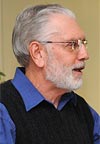






Including UE, workers from seven national unions were at the expanded CBC meeting hosted by UAW Local 643 and IAM Lodge 912. The other unions were: International Union of Electronic Workers-Communications Workers of America (IUE-CWA), International Association of Machinists (IAM), United Auto Workers (UAW), International Brotherhood of Electrical Workers (IBEW), United Steelworkers (USW) and International Federation of Professional and Technical Employees (IFPTE).
Evandale, OH
General Electric workers are anticipating difficult national negotiations with the company this spring, so national and local union leaders gathered on January 8 for an expanded meeting of the Coordinated Bargaining Committee of GE Unions (CBC). Delegates assessed the strength of the two sides, analyzed expected company attacks on benefits, and discussed tactics for mobilizing union members to fight back.
The meeting was hosted by UAW Local 643 and IAM Lodge 912, which represent workers at GE’s aircraft engine plant in Evandale, just north of Cincinnati, and held in Local 643’s union hall.
Leaders of UE locals 332, 506 and 618 GE participated in a meeting that involved 125 leaders of some 30 local unions. Participating locals included affiliates of six national unions besides UE: the International Union of Electronic Workers-Communications Workers of America (IUE-CWA), International Association of Machinists (IAM), United Auto Workers (UAW), International Brotherhood of Electrical Workers (IBEW), United Steelworkers (USW) and International Federation of Professional and Technical Employees (IFPTE).
The evening before the meeting, UAW Local 643 hosted a social gathering at its hall.
Even at that event, folks got down to business, with leaders of each local getting up to briefly report on the situation at their workplaces. The Saturday session kicked off with opening remarks by Jim Clark, president of IUE-CWA and chair of the CBC. Bob Santamour, chair of the IUE-CWA’s GE Conference Board, spoke on bargaining priorities and stressed the importance of not getting bogged down in defensive issues; the unions must fight for improvements in the contract.
Myths & Realities
Steve Tormey, secretary of the UE-GE Conference Board, delivered a comprehensive PowerPoint presentation on “GE Medical Insurance and Pensions: Some Myths and Realities.” The company constantly whines about its rising medical costs, but Tormey showed that GE’s healthcare costs remain less than 1 percent of the company’s revenues, and its cost increases have been far below average. GE’s medical costs rose about 32 percent from 2002 to 2009, and in the four years from 2006 to the end of 2009, GE’s increase in healthcare spending averaged only 2.4 percent per year. Since 2002, the national average increase in employers’ costs for family medical coverage increased 89.4 percent. Tormey also demonstrated that GE is “swimming in cash” – Dow Jones Newswires reported in December that “GE has the firepower to spend ‘$30 billionish’ on acquisitions over the next two to three years.” In other words, GE is poised for another binge of swallowing up other companies.
Tormey warned of the dangers of GE’s “Health Choice” plan, already imposed on the company’s non-exempt salaried workers last year. Health Choice is a so-called “consumer-driven” health plan featuring sky-high deductibles and co-pays, and it breaks up the pool of insured individuals and families into three “options.” This “shattering the risk pool” means that many younger and healthier workers are likely to choose the “option” with the lowest paycheck contributions but the highest deductible. The effect is to leave the other option groups with mostly older workers and those with more health problems, which will end driving their insurance costs even higher. Another effect of high-deductible high-co-pay health plans such as Health Choice is that people avoid or delay getting needed medical care, and as a result they get sicker.
Far from being a victim of the healthcare crisis, Tormey said, “GE is part of the problem.” The company makes big profits from the healthcare industry – from lending hospitals money for expansion projects to selling them big-ticket diagnostic equipment, and GE refused to support stronger reforms in 2009’s national healthcare debate. “GE likes the current chaotic healthcare system because it’s very profitable to them,” said Tormey.
Tormey also discussed the threat to the GE pension, which came to light when the company announced that effective January 1, 2011, newly-hired exempt salaried employees would no longer be eligible to participate in the pension. The GE pension plan is financially very healthy, and GE has not needed to contribute a dime to the fund since 1987. Any attempt by GE to attack the pension is outrageous and economically unjustified.
CBC History
UE President John Hovis spoke on the CBC’s history of solidarity. It was formed in the 1960s in response to 20 years of labor division within GE which allowed the company to impose its contract terms without real bargaining. The CBC was solidified when the unions jointly conducted a successful 102-day national strike against GE in 1969-70. The strike was successful and broke the back of GE’s “take-it-or-leave-it” bargaining policy known as Boulwarism (after its originator, GE Vice President Lemuel Boulware).
Along with the 1969 national strike, the unions won favorable labor board rulings upholding the legal right of a union to have representatives of other unions as part of its bargaining committee. The unions also gradually lined up the expiration dates of their contracts so they all bargain at the same time. As a result, members of the UAW, IAM, IBEW, Steelworkers and other unions now participate at the bargaining tables of the UE and the IUE – the two unions covered by national agreements. “We also won the fight to include whatever terms we negotiate into the UE and IUE national contracts in the local contracts of the other GE unions,” said Hovis. GE didn’t like coordinated bargaining when it began and they still don’t like it, he said.
“It’s not a perfect system,” Hovis added. “We have our internal disagreements, but it has continued to work well for GE workers and their families. We need to approach these upcoming negotiations with the same commitment to our members and determination to work together to win a fair agreement, as we have done so many times in the past.”
An overview of GE’s financial performance was presented by Neil Gladstein, the IAM director of strategic resources. During the afternoon session, delegates met in smaller breakout groups. One of these dealt in more detail with GE’s “Health Choice” and the union response. A second group consisted of delegates from several locals in the GE aircraft engine division. Two other groups worked on ideas and tactics for locals to mobilize their members for this year’s negotiations. The final portion of the meeting was report-backs to the entire group on the conclusions reached by the four breakout groups.
